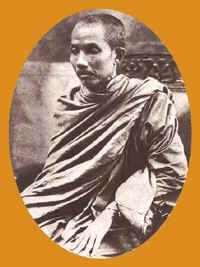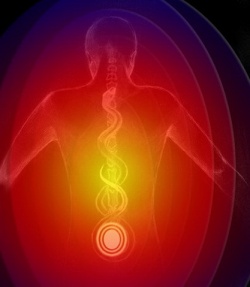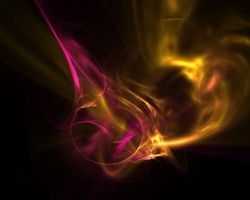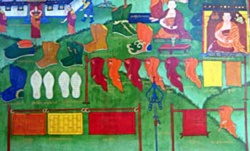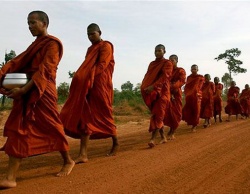Difference between revisions of "Vajirananavarorasa"
| Line 9: | Line 9: | ||
[[Vajirañana]] was born in the Grand Palace as the 4th child of Phae, one of [[King]] Mongkut's concubines. She [[died]] after giving [[birth]] to her fifth child, a daughter, when he was one year old. He was then fostered by a maternal [[relative]] ({{Wiki|Princess}} [[Varaseṭhasutā]], "[[Putrī]]", daughter of [[King]] [[Wikipedia:Nangklao|Rama III]]) and her mother (a {{Wiki|royal}} {{Wiki|concubine}} named [[Samaśakti]] or "[[Ueng]]"). | [[Vajirañana]] was born in the Grand Palace as the 4th child of Phae, one of [[King]] Mongkut's concubines. She [[died]] after giving [[birth]] to her fifth child, a daughter, when he was one year old. He was then fostered by a maternal [[relative]] ({{Wiki|Princess}} [[Varaseṭhasutā]], "[[Putrī]]", daughter of [[King]] [[Wikipedia:Nangklao|Rama III]]) and her mother (a {{Wiki|royal}} {{Wiki|concubine}} named [[Samaśakti]] or "[[Ueng]]"). | ||
| − | In the palace he learned the Siamese [[alphabet]] by a woman ("[[Nok Panakngan]]"). A nobleman ([[Phraya Pariyatidharrmadhātā]], "[[Piam]]", then called [[Luang Rājābhirama]]), deputy head of the {{Wiki|Royal}} [[Pundits]] Department, came to the Palace to teach the seven or eight year old [[Vajirañana]] (and other princes) the {{Wiki|Khmer}} script used to inscribe [[religious]] texts (in [[Pali]]). With a [[teacher]] who was official at the Outer Court, [[Vajirañana]] studied [[Padamālā]] (i.e. [[Pali]] {{Wiki|grammar}}), the [[Dhammapada]] commentary etc. until 1868. When his elder brother, {{Wiki|Prince}} Brahmavarānurakṣa, [[ordained]] as a [[novice]], [[Vajirañana]] was allowed to live with him in Wat Pavaraniveśa for some while. There he occasionally studied [[Pali]] [[scripture]] with [[Phra]] [[Pariyatidharrmadhātā]] ("[[Chang]]", then [[Luang Śrīvaravohāra]]), one of the four section chiefs in the [[Royal Pundits Department]], who [[taught]] [[monks]] and novices at the [[monastery]]. | + | In the palace he learned the [[Siamese]] [[alphabet]] by a woman ("[[Nok Panakngan]]"). A nobleman ([[Phraya Pariyatidharrmadhātā]], "[[Piam]]", then called [[Luang Rājābhirama]]), deputy head of the {{Wiki|Royal}} [[Pundits]] Department, came to the Palace to teach the seven or eight year old [[Vajirañana]] (and other princes) the {{Wiki|Khmer}} [[script]] used to inscribe [[religious]] texts (in [[Pali]]). With a [[teacher]] who was official at the Outer Court, [[Vajirañana]] studied [[Padamālā]] (i.e. [[Pali]] {{Wiki|grammar}}), the [[Dhammapada]] commentary etc. until 1868. When his elder brother, {{Wiki|Prince}} Brahmavarānurakṣa, [[ordained]] as a [[novice]], [[Vajirañana]] was allowed to live with him in [[Wat Pavaraniveśa]] for some while. There he occasionally studied [[Pali]] [[scripture]] with [[Phra]] [[Pariyatidharrmadhātā]] ("[[Chang]]", then [[Luang Śrīvaravohāra]]), one of the four section chiefs in the [[Royal Pundits Department]], who [[taught]] [[monks]] and novices at the [[monastery]]. |
After his father had [[died]] in 1868 and his elder half brother [[Chulalongkorn]] had come to the [[throne]], [[Vajirañana]] was back at the palace, receiving more [[education]] from his foster aunt, {{Wiki|Princess}} [[Varaseṭhasutā]]. With her he practised reading and [[writing]] [[Wikipedia:Thai language|Siamese]], and he was [[taught]] verse [[forms]], [[Wikipedia:Thai language|Siamese]] {{Wiki|arithmetic}}, and [[astrology]]. | After his father had [[died]] in 1868 and his elder half brother [[Chulalongkorn]] had come to the [[throne]], [[Vajirañana]] was back at the palace, receiving more [[education]] from his foster aunt, {{Wiki|Princess}} [[Varaseṭhasutā]]. With her he practised reading and [[writing]] [[Wikipedia:Thai language|Siamese]], and he was [[taught]] verse [[forms]], [[Wikipedia:Thai language|Siamese]] {{Wiki|arithmetic}}, and [[astrology]]. | ||
| − | [[King]] Chulalongkorn founded an English {{Wiki|medium}} school on the palace ground and hired the Englishman Francis George Patterson for providing {{Wiki|Western}} [[education]]. When the school first opened in 1872, [[Vajirañana]] began to study there. Patterson instructed the brothers of the [[king]] in the morning and the boys from the {{Wiki|Royal}} Pages' Bodyguard Regiment in the afternoon. Patterson could not speak Siamese, and he used {{Wiki|European}} textbooks, [[teaching]] English and {{Wiki|French}} (reading, [[writing]] and {{Wiki|speaking}}), {{Wiki|mathematics}} and also some {{Wiki|European}} history and {{Wiki|geography}}. [[Vajirañana]] and {{Wiki|Prince}} [[Wikipedia:Damrong Rajanubhab|Damrong Rajanubhab]] were the most diligent of Patterson's students. [[Vajirañana]] continued the [[education]] with Patterson until 1875. | + | [[King]] [[Chulalongkorn]] founded an English {{Wiki|medium}} school on the palace ground and hired the Englishman Francis George Patterson for providing {{Wiki|Western}} [[education]]. When the school first opened in 1872, [[Vajirañana]] began to study there. Patterson instructed the brothers of the [[king]] in the morning and the boys from the {{Wiki|Royal}} Pages' Bodyguard Regiment in the afternoon. Patterson could not speak [[Siamese]], and he used {{Wiki|European}} textbooks, [[teaching]] English and {{Wiki|French}} (reading, [[writing]] and {{Wiki|speaking}}), {{Wiki|mathematics}} and also some {{Wiki|European}} history and {{Wiki|geography}}. [[Vajirañana]] and {{Wiki|Prince}} [[Wikipedia:Damrong Rajanubhab|Damrong Rajanubhab]] were the most diligent of Patterson's students. [[Vajirañana]] continued the [[education]] with Patterson until 1875. |
| − | With 13 years [[Vajirañana]] [[ordained]] as a [[novice]] for 78 days (on 7 August 1873), with {{Wiki|Prince}} Pavareś (สมเด็จพระมหาสมณเจ้า กรมพระยาปวเรศวริยาลงกรณ์, "{{Wiki|Prince}} Roek" ฤกษ์, 1809–1892) as his [[preceptor]]. As a [[novice]], he lived in Wat Pavaraniveśa, in a small residence known as the printshop: His father, [[King]] {{Wiki|Mongkut}}, once had lived there as a [[monk]] and had printed his [[Ariyaka script]] there. | + | With 13 years [[Vajirañana]] [[ordained]] as a [[novice]] for 78 days (on 7 August 1873), with {{Wiki|Prince}} Pavareś (สมเด็จพระมหาสมณเจ้า กรมพระยาปวเรศวริยาลงกรณ์, "{{Wiki|Prince}} Roek" ฤกษ์, 1809–1892) as his [[preceptor]]. As a [[novice]], he lived in [[Wat Pavaraniveśa]], in a small residence known as the printshop: His father, [[King]] {{Wiki|Mongkut}}, once had lived there as a [[monk]] and had printed his [[Ariyaka script]] there. |
| − | After having [[disrobed]] from his novicehood, [[Vajirañana]] got his first bigger amount of [[money]] to spend and discovered the [[world]] of consume. But in 1876, he met the young (between 25 and 30) {{Wiki|Scottish}} [[physician]] Dr. Peter Gowan. Dr. Gowan [[taught]] him English here and then and a little about [[medicine]], and he had a big influence on [[Vajirañana's]] [[life]] conduct (stop [[smoking]], drinking and some prodigal or even dissolute [[habits]]). Getting more and more attracted to the [[monastery]], [[Vajirañana]] went to visit his uncle, the then Supreme [[Patriarch]] [[Prince Pavareś]]. By him, [[Vajirañana]] was given instruction in [[poetry]], [[astrology]], and [[Buddhist scripture]] in 1876. He learned some additional [[astrology]] (i.e. how to do calendars) from two other [[teachers]], [[Khun Debyākaraṇa]] ("That") and "Pia" ([[Phrakrupalat Suvaḍhanasutaguṇa]] at [[Wat Rājapratiṣṭha]]). Under the guidance of [[Prince Pavareś]], [[Vajirañana]] also took up the study of [[Dhamma]]. He also invited one of his former [[Pali]] [[teachers]], [[Phra Pariyatidharrmadhātā]] ("[[Chang]]"), to come to the [[monastery]] to instruct him in [[Pali]] again. | + | After having [[disrobed]] from his novicehood, [[Vajirañana]] got his first bigger amount of [[money]] to spend and discovered the [[world]] of consume. But in 1876, he met the young (between 25 and 30) {{Wiki|Scottish}} [[physician]] Dr. [[Peter Gowan]]. [[Dr. Gowan]] [[taught]] him English here and then and a little about [[medicine]], and he had a big influence on [[Vajirañana's]] [[life]] conduct (stop [[smoking]], drinking and some prodigal or even dissolute [[habits]]). Getting more and more attracted to the [[monastery]], [[Vajirañana]] went to visit his uncle, the then Supreme [[Patriarch]] [[Prince Pavareś]]. By him, [[Vajirañana]] was given instruction in [[poetry]], [[astrology]], and [[Buddhist scripture]] in 1876. He learned some additional [[astrology]] (i.e. how to do calendars) from two other [[teachers]], [[Khun Debyākaraṇa]] ("That") and "Pia" ([[Phrakrupalat Suvaḍhanasutaguṇa]] at [[Wat Rājapratiṣṭha]]). Under the guidance of [[Prince Pavareś]], [[Vajirañana]] also took up the study of [[Dhamma]]. He also invited one of his former [[Pali]] [[teachers]], [[Phra Pariyatidharrmadhātā]] ("[[Chang]]"), to come to the [[monastery]] to instruct him in [[Pali]] again. |
[[Vajirañana]] has always been very critical about the methods by which students learned [[Pali]] and would later rewrite the texts for [[Pali]] studies. | [[Vajirañana]] has always been very critical about the methods by which students learned [[Pali]] and would later rewrite the texts for [[Pali]] studies. | ||
| Line 39: | Line 39: | ||
In 1892, [[Prince Pavareś]] [[died]]. [[Vajirañana]] became his successor as [[abbot]] of [[Wat Pavaraniveśa]] and as the [[patriarch]] of the [[Dhammayuttika order]], while Sa Pussadevo became the new Supreme [[Patriarch]]. | In 1892, [[Prince Pavareś]] [[died]]. [[Vajirañana]] became his successor as [[abbot]] of [[Wat Pavaraniveśa]] and as the [[patriarch]] of the [[Dhammayuttika order]], while Sa Pussadevo became the new Supreme [[Patriarch]]. | ||
| − | On 1 October 1893, the [[Mahāmakuṭa Royal Academy]] ([[Mahamakut Buddhist University]]) was opened. [[Vajirañana]] now could carry out his reforms concerning the study of [[Pali]] and the [[Dhamma]]. [[Vajirañana]] wrote a [[Pali]] {{Wiki|grammar}} and several textbooks. He also designed the university's {{Wiki|curriculum}}. It consisted of {{Wiki|secular}} [[subjects]] such as reading and [[writing]] [[Wikipedia:Thai people|Siamese]], history, and some [[science]] beside [[religious]] studies and the preparation for the [[Pali]] exam, as the new {{Wiki|academy}} also served the {{Wiki|purpose}} of training [[monks]] to become [[teachers]]. In 1898, [[King]] {{Wiki|Chulalongkorn}} ordered [[Prince Damrong]] and [[Vajirañana]] to find a possible solution for providing the whole country with a primary [[education]]. Due to the lack of [[money]] the solution was to let the educated [[monks]] be the [[teachers]] of the villages in the outer provinces. (This plan, however, was not further pursued after 1902.) | + | On 1 October 1893, the [[Mahāmakuṭa Royal Academy]] ([[Mahamakut Buddhist University]]) was opened. [[Vajirañana]] now could carry out his reforms concerning the study of [[Pali]] and the [[Dhamma]]. [[Vajirañana]] wrote a [[Pali]] {{Wiki|grammar}} and several textbooks. He also designed the university's {{Wiki|curriculum}}. It consisted of {{Wiki|secular}} [[subjects]] such as reading and [[writing]] [[Wikipedia:Thai people|Siamese]], history, and some [[science]] beside [[religious]] studies and the preparation for the [[Pali]] exam, as the new {{Wiki|academy}} also served the {{Wiki|purpose}} of {{Wiki|training}} [[monks]] to become [[teachers]]. In 1898, [[King]] {{Wiki|Chulalongkorn}} ordered [[Prince Damrong]] and [[Vajirañana]] to find a possible {{Wiki|solution}} for providing the whole country with a primary [[education]]. Due to the lack of [[money]] the {{Wiki|solution}} was to let the educated [[monks]] be the [[teachers]] of the villages in the outer provinces. (This plan, however, was not further pursued after 1902.) |
| − | In 1894, [[Vajirañana]] opened the first [[Buddhist]] journal in {{Wiki|Siam}}, the [[Dhammacakṣu]] ('[[Eye of Dhamma]]'). It contained news of the {{Wiki|academy}}, articles on [[Buddhism]], and sermons. | + | In 1894, [[Vajirañana]] opened the first [[Buddhist]] journal in {{Wiki|Siam}}, the [[Dhammacakṣu]] ('[[Eye of Dhamma]]'). It contained news of the {{Wiki|academy}}, articles on [[Buddhism]], and [[sermons]]. |
| − | While the ]]Mahāmakuṭa |{{Wiki|Royal}} {{Wiki|Academy}}]] belonged to the [[Dhammayuttika order]], [[King]] {{Wiki|Chulalongkorn}} also strengthened the school of the [[Mahānikāya]] order in the [[Wat Mahādhātu]] which in 1896 became the [[Mahachulalongkornrajavidyalaya University]]. The [[Sangha]] {{Wiki|unity}} was also strengthened by the [[decision]] to hold the [[Pali]] examination in two sets: one at [[Mahamakuta Academy]], where [[Vajirañana's]] new {{Wiki|curriculum}} and a written examination format would be used, and one at the Grand Palace chapel, where the [[traditional]] oral translations would be heard. | + | While the ]]Mahāmakuṭa |{{Wiki|Royal}} {{Wiki|Academy}}]] belonged to the [[Dhammayuttika order]], [[King]] {{Wiki|Chulalongkorn}} also strengthened the school of the [[Mahānikāya]] order in the [[Wat Mahādhātu]] which in 1896 became the [[Mahachulalongkornrajavidyalaya University]]. The [[Sangha]] {{Wiki|unity}} was also strengthened by the [[decision]] to hold the [[Pali]] {{Wiki|examination}} in two sets: one at [[Mahamakuta Academy]], where [[Vajirañana's]] new {{Wiki|curriculum}} and a written {{Wiki|examination}} format would be used, and one at the Grand Palace chapel, where the [[traditional]] oral translations would be heard. |
The [[First Sangha Act]] of 1902 established a new administration of the [[Sangha]] in the whole country. (...) | The [[First Sangha Act]] of 1902 established a new administration of the [[Sangha]] in the whole country. (...) | ||
| Line 53: | Line 53: | ||
==Later years, 1910-1921== | ==Later years, 1910-1921== | ||
| − | After the accession of the [[throne]] by [[King]] Vajiravudh in 1910, [[Vajirañana]] was appointed [[Supreme Patriarch]]. | + | After the accession of the [[throne]] by [[King]] [[Vajiravudh]] in 1910, [[Vajirañana]] was appointed [[Supreme Patriarch]]. |
| − | In 1921, [[King]] Vajiravudh created the {{Wiki|honorary}} title [[phramahasamanachao]] for the [[Supreme Patriarch]]. | + | In 1921, [[King]] [[Vajiravudh]] created the {{Wiki|honorary}} title [[phramahasamanachao]] for the [[Supreme Patriarch]]. |
[[Vajirañana]] continued his work in [[religious]] [[education]], [[Sangha]] administration and {{Wiki|scholarship}}. He breathed new [[life]] to the [[Council of Elders]] ([[Thera]]), founded by the [[Sangha Act]] of 1902. | [[Vajirañana]] continued his work in [[religious]] [[education]], [[Sangha]] administration and {{Wiki|scholarship}}. He breathed new [[life]] to the [[Council of Elders]] ([[Thera]]), founded by the [[Sangha Act]] of 1902. | ||
| − | Publication of [[Thalaeng kan khanasong]] [[Announcement of Sangha Affairs]] which spread rules for the whole [[Sangha]] within the country. | + | Publication of [[Thalaeng kan khanasong]] [[Announcement of Sangha Affairs]] which spread {{Wiki|rules}} for the whole [[Sangha]] within the country. |
1912-1917 [[Vajirañana]] travels to the provinces to examine the situation of the [[Sangha]]. | 1912-1917 [[Vajirañana]] travels to the provinces to examine the situation of the [[Sangha]]. | ||
Latest revision as of 10:20, 24 February 2015
Vajirananavarorasa (also spelled Wachirayan, Watchirayanawarorot, correct Pali spelling: Vajirañāṇavarorasa, Thai: วชิรญาณวโรรส, full title Somdet Phramahasamanachao Kromphraya Vajirananavarorasa สมเด็จพระมหาสมณเจ้ากรมพระยาวชิรญาณวโรรส ) (April 12, 1860, Bangkok, Thailand - August 2, 1921, Bangkok, Thailand) was the 10th Supreme Patriarch of Thailand from 1910 to 1921 . He helped to institutionalize Thai Buddhism.
Vajirañana was the 47th child of King Mongkut and was destined to become "the leading intellectual of his generation in Siam", in the words of the Thai historian David K. Wyatt (cited in Reynolds 1979:xiii). His royal name was Prince Manuṣyanāgamānob (พระองค์เจ้ามนุษยนาคมานพ) ('he who is a nāga among men') . Vajirañāṇavarorasa is the name he received on a gold nameplate together with the krommamuen rank on 16 March 1882.
Childhood and early education
Vajirañana was born in the Grand Palace as the 4th child of Phae, one of King Mongkut's concubines. She died after giving birth to her fifth child, a daughter, when he was one year old. He was then fostered by a maternal relative (Princess Varaseṭhasutā, "Putrī", daughter of King Rama III) and her mother (a royal concubine named Samaśakti or "Ueng").
In the palace he learned the Siamese alphabet by a woman ("Nok Panakngan"). A nobleman (Phraya Pariyatidharrmadhātā, "Piam", then called Luang Rājābhirama), deputy head of the Royal Pundits Department, came to the Palace to teach the seven or eight year old Vajirañana (and other princes) the Khmer script used to inscribe religious texts (in Pali). With a teacher who was official at the Outer Court, Vajirañana studied Padamālā (i.e. Pali grammar), the Dhammapada commentary etc. until 1868. When his elder brother, Prince Brahmavarānurakṣa, ordained as a novice, Vajirañana was allowed to live with him in Wat Pavaraniveśa for some while. There he occasionally studied Pali scripture with Phra Pariyatidharrmadhātā ("Chang", then Luang Śrīvaravohāra), one of the four section chiefs in the Royal Pundits Department, who taught monks and novices at the monastery.
After his father had died in 1868 and his elder half brother Chulalongkorn had come to the throne, Vajirañana was back at the palace, receiving more education from his foster aunt, Princess Varaseṭhasutā. With her he practised reading and writing Siamese, and he was taught verse forms, Siamese arithmetic, and astrology.
King Chulalongkorn founded an English medium school on the palace ground and hired the Englishman Francis George Patterson for providing Western education. When the school first opened in 1872, Vajirañana began to study there. Patterson instructed the brothers of the king in the morning and the boys from the Royal Pages' Bodyguard Regiment in the afternoon. Patterson could not speak Siamese, and he used European textbooks, teaching English and French (reading, writing and speaking), mathematics and also some European history and geography. Vajirañana and Prince Damrong Rajanubhab were the most diligent of Patterson's students. Vajirañana continued the education with Patterson until 1875.
With 13 years Vajirañana ordained as a novice for 78 days (on 7 August 1873), with Prince Pavareś (สมเด็จพระมหาสมณเจ้า กรมพระยาปวเรศวริยาลงกรณ์, "Prince Roek" ฤกษ์, 1809–1892) as his preceptor. As a novice, he lived in Wat Pavaraniveśa, in a small residence known as the printshop: His father, King Mongkut, once had lived there as a monk and had printed his Ariyaka script there.
After having disrobed from his novicehood, Vajirañana got his first bigger amount of money to spend and discovered the world of consume. But in 1876, he met the young (between 25 and 30) Scottish physician Dr. Peter Gowan. Dr. Gowan taught him English here and then and a little about medicine, and he had a big influence on Vajirañana's life conduct (stop smoking, drinking and some prodigal or even dissolute habits). Getting more and more attracted to the monastery, Vajirañana went to visit his uncle, the then Supreme Patriarch Prince Pavareś. By him, Vajirañana was given instruction in poetry, astrology, and Buddhist scripture in 1876. He learned some additional astrology (i.e. how to do calendars) from two other teachers, Khun Debyākaraṇa ("That") and "Pia" (Phrakrupalat Suvaḍhanasutaguṇa at Wat Rājapratiṣṭha). Under the guidance of Prince Pavareś, Vajirañana also took up the study of Dhamma. He also invited one of his former Pali teachers, Phra Pariyatidharrmadhātā ("Chang"), to come to the monastery to instruct him in Pali again.
Vajirañana has always been very critical about the methods by which students learned Pali and would later rewrite the texts for Pali studies.
Although Vajirañana frequented the monastery, he could not yet decide himself to become a monk. From 12 July 1877, he also worked as a legal secretary for King Chulalongkorn for two years. King Chulalongkorn needed a reliable person such as Vajirañana in the Sangha, and he tried to persuade him to remain in the monkhood after he would have ordained as a monk according to the custom. Vajirañana was not yet sure, but he promised that if he were to disrobe he would do so at the end of the first Rains. If he lasted beyond that he would not disrobe. King Chulalongkorn then promised him to confer on him a princely rank and title if he remained in the monkhood for three Rains. (The King kept his promise by doing so in 1882.)
Ordination and early years in the Sangha, 1879-1892
On 27 June 1879, Vajirañana received his full ordination as a monk in the Royal Chapel with Prince Pavareś (aged 71) as his preceptor. Another senior monk, Phra Candragocaraguṇa (Candrarańsī), abbot of Wat Makuṭakṣatriya, assisted in the ceremony (as kammavācācariya).
After the ordination ceremony, Vajirañana spent the first Rains in Wat Pavaraniveśa studying Pali (e.g. with the Dhammapada commentary) and Buddhist scripture . One of his former Pali teachers, Phra Pariyatidharrmadhātā ("Chang") was his teacher.
After the Rains, in November 1879, Vajirañana moved to Wat Makuṭakṣatriya (then called Wat Nāmabaññati). There he studied Pali (the Mańgalatthadīpanī) under Chaokhun Phra Brahmamunī (Kittisāra).
On 3 January 1880, Vajirañana was reordinated in the orthodox Dhammayuttika manner on a raft, Chaokhun Dharrmatrailoka (Ṭhānacāra) being his preceptor. He continued to live in Wat Makuṭakṣatriya as a pupil and personal attendant of Phra Candragocaraguṇa, and as a Pali student of Phra Brahmamunī.
On 25 December 1881, Vajirañana began his Pali exam, the supreme patriarch being his examiner.
Middle years, 1892-1910
In 1892, Prince Pavareś died. Vajirañana became his successor as abbot of Wat Pavaraniveśa and as the patriarch of the Dhammayuttika order, while Sa Pussadevo became the new Supreme Patriarch.
On 1 October 1893, the Mahāmakuṭa Royal Academy (Mahamakut Buddhist University) was opened. Vajirañana now could carry out his reforms concerning the study of Pali and the Dhamma. Vajirañana wrote a Pali grammar and several textbooks. He also designed the university's curriculum. It consisted of secular subjects such as reading and writing Siamese, history, and some science beside religious studies and the preparation for the Pali exam, as the new academy also served the purpose of training monks to become teachers. In 1898, King Chulalongkorn ordered Prince Damrong and Vajirañana to find a possible solution for providing the whole country with a primary education. Due to the lack of money the solution was to let the educated monks be the teachers of the villages in the outer provinces. (This plan, however, was not further pursued after 1902.)
In 1894, Vajirañana opened the first Buddhist journal in Siam, the Dhammacakṣu ('Eye of Dhamma'). It contained news of the academy, articles on Buddhism, and sermons.
While the ]]Mahāmakuṭa |Royal Academy]] belonged to the Dhammayuttika order, King Chulalongkorn also strengthened the school of the Mahānikāya order in the Wat Mahādhātu which in 1896 became the Mahachulalongkornrajavidyalaya University. The Sangha unity was also strengthened by the decision to hold the Pali examination in two sets: one at Mahamakuta Academy, where Vajirañana's new curriculum and a written examination format would be used, and one at the Grand Palace chapel, where the traditional oral translations would be heard.
The First Sangha Act of 1902 established a new administration of the Sangha in the whole country. (...)
In 1906 King Chulalongkorn raised Vajirañana's princely rank to krommaluang, although it was not royal custom to promote prince-monks until they reached advanced age. But Vajirañana should not be at a disadvantage in comparison with his brothers.
From 1900 to 1910 the position of Supreme Patriarch of Thailand remained vacant. Reynolds speculates that King Chulalongkorn didn't want to appoint a successor to the 9th Patriarch because a senior monk might have been too conservative to support the ongoing reforms, and Vajirañana might have been still too young to be able to assert his reforms against the will of the conservative senior monks.
Later years, 1910-1921
After the accession of the throne by King Vajiravudh in 1910, Vajirañana was appointed Supreme Patriarch.
In 1921, King Vajiravudh created the honorary title phramahasamanachao for the Supreme Patriarch.
Vajirañana continued his work in religious education, Sangha administration and scholarship. He breathed new life to the Council of Elders (Thera), founded by the Sangha Act of 1902.
Publication of Thalaeng kan khanasong Announcement of Sangha Affairs which spread rules for the whole Sangha within the country.
1912-1917 Vajirañana travels to the provinces to examine the situation of the Sangha.
1912 Creation of a new curriculum for Dhamma studies which does not require previous Pali studies.
On 2 August 1921 Vajirañana died of tuberculosis.
